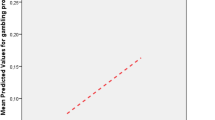Abstract
The study takes a closer look at at-risk gamblers, with the objective to see how they differ from no-risk gamblers. The data comes from a national gambling survey in 2002, and the age group is 15–74 years. The sample consists of 4188 current gamblers with no current gambling problems or pathology. The analysis includes cross-tabulations and a logistic regression. The results show that at-risk gamblers differed substantially from no-risk gamblers in terms of demographic characteristics, gambling behaviour and the presence of other assumed risk factors. Demographic segments with a higher risk of falling into the at-risk group are men, young people, divorced or single people, and non-western immigrants. Furthermore, gambling problems in the family, beginners luck and misconceptions about winning chances significantly increased the odds for at-risk gambling. The study concludes that at-risk gamblers deserve more attention from research, that their similarity with problem gamblers increases the likelihood that many of them will eventually develop a gambling problem, and that their tendency to be superstitious about winning chances might be exploited in preventive work.
Similar content being viewed by others
References
Abbott, M. Do EGMs and problem gambling go together like a horse and carriage? Manuscript accepted by Gambling Research (in press).
Abbott, M., & Volberg, R. A. (2000). Taking the pulse on gambling and problem gambling in New Zealand:A report on phase one of the 1999 prevalence survey, report no three of the New Zealand gaming survey. Wellington, New Zealand: Department of internal affairs.
Benhsain, K., Taillefer, A., & Ladouceur, R. (2004). Awareness of independence of events and erroneous perceptions while gambling. Addictive Behaviors, 29, 399–404.
Black, D. W., Monahan, P. O., Temkit, M., & Shaw, M. (2006). A family study of pathological gambling. Psychiatric Research, 141(3), 295–303.
Bonke, J., & Borregaard, K. (2006). Ludomani i Danmark. Udbredelsen af pengespil og problemspillere (Ludomania in Denmark. The prevalence of gambling and problem gamblers). Copenhagen: Report from the Institute for Social Research.
Cornish, D. (1978). Gambling: A review of the literature and its implications for policy and research. Home office research study (Vol. 42), London: HMSO.
Delfabbro, P. (2004). The stubborn logic of regular gamblers: Obstacles and dilemmas in cognitive gambling research. Journal of Gambling Studies, 20(1), 1–21.
Gerstein, D., Hoffmann, J., & Larison, C. et al. (1999). Gambling impact and behavior study. Report to the national gambling impact study commission, Chicago, USA: National Opinion Research Center at the University of Chicago.
Gøtestam, K.G., & Johansson, A. (2003). Characteristics of gambling and problematic gambling in the Norwegian context. A DSM-IV-based telephone interview study. Addictive Behaviours, 28, 189–197.
Ilkas, H., & Turja, T. (2003). Penningspelsundersökning (Study of gambling). Helsinki, Finland: Ministry of Social and Health.
Johansson, A., & Götestam K. G. (2004). Risk factors for problematic gambling: A critical literature review. Research report from section for psychiatric and behavioural medicine. Trondheim, Norway: Department of Neuroscience, The Norwegian University of Science and Technology.
Joukhador, J., Blaszczynski, A., & Maccallum, F. (2004). Superstitious beliefs in gambling among problem and non-problem gamblers: Preliminary data. Journal of Gambling Studies, 20(2), 171–180.
Kavli, H, & Berntsen, W. (2005). Undersøkelse om pengespill. Spillevaner og spilleproblemer i befolkningen (Study of gambling, gambling habits and gambling problems in the population). Oslo, Norway: Report from MMI (Market and Media Institute.
Lesieur, H. R. (1994). Epidemiological surveys of pathological gambling: Critique and suggestions for modification. Journal of Gambling Studies 10(4), pp 385–398.
Lund, I., & Nordlund, S. (2003). Pengespill og pengespillproblemer i Norge. (Gambling and problem gambling in Norway.) SIRUS report no 2. Oslo: Norwegian Institute for Alcohol and Drug Research.
Lund I. (2006). Gambling and problem gambling in Norway: What part does the gambling machine play? Addiction Research and Theory, 14(5), 1–17.
Orford, J., Sproston, K., Erens, B., White, C., & Mitchell, L. (2003). Gambling and problem gambling in Britain. Hove and New York: Brunner-Routledge.
Rönnberg, S., Volberg, R. A., Abbott, M., Moore, L., Andrén, A., Munck, I., Jonsson, J., Nilsson, T., & Svensson, O. (1999). Spel och spelberoende i Sverige. (Gambling and problem gambling in Sweden) Rapport nr 3 i Folkhälsoinstitutets serie om spel och spelberoende, Stockholm, 1999.
Schrans, T. & Schellinck, T. (2004). 2003 Nova scotia gambling prevalence study. Nova Scotia Office of Health Promotion Final Report, Focal Research.
Shaffer, H. J., Hall, M. N., & Vander Bilt, J. (1997). Estimating the prevalence of disordered gambling behavior in the United States and Canada: A meta-analysis. Boston: Presidents and Fellows of Harvard College.
SIRUS (2002). Gambling survey. Oslo: Norwegian Institute for Alcohol and Drug Research, SIRUS.
Sproston, K., Erens, B., & Orford, J. (2000). gambling behaviour in britain. Results from the british gambling prevalence study. London: National Centre for Social Research.
Statistics Norway (2003). http://www.ssb.no/.
The Norwegian Gaming and Foundation Authority (2006). http://www.lotteritilsynet.no/
Wiebe, J., Single, E. & Falowski-Ham, A. (2001). Measuring gambling and problem gambling in ontario. Ontario: Canadian Centre on Substance Abuse, Responsible Gambling Council.
Williams R. J., & Connolly, D. (2006). Does learning about the mathematics of gambling change gambling behavior? Psychology of Addictive Behaviors, 20(1), 62–68.
Acknowledgments
The study is funded by the Norwegian Institute for Alcohol and Drug Research (SIRUS). The author thanks an anonymous referee for helpful comments on an earlier version of the paper.
Author information
Authors and Affiliations
Corresponding author
Rights and permissions
About this article
Cite this article
Lund, I. Lessons from the Grey Area: A Closer Inspection of At-risk Gamblers. J Gambl Stud 23, 409–419 (2007). https://doi.org/10.1007/s10899-007-9058-4
Received:
Accepted:
Published:
Issue Date:
DOI: https://doi.org/10.1007/s10899-007-9058-4



